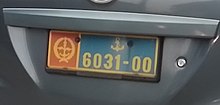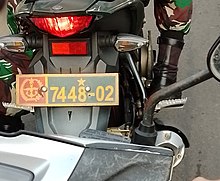|
Vehicle registration plates of Indonesia
Motorized vehicles in Indonesia are required to have registration plates, which must be displayed both at the front and back of the vehicles. The issuing of number plates is regulated and administered by SAMSAT (Indonesian: Sistem Administrasi Manunggal Satu Atap, lit. 'One-stop Administration Services Office'), which is a collaboration between the Indonesian National Police, provincial offices of regional revenue, and the national mandatory vehicle insurance operator Jasa Raharja. Registration area codesThe lettering convention denoting the area of registration is a legacy of the Dutch colonial era and does not reflect the current regional divisions of the country into provinces. They follow the old system of Dutch Karesidenan or residencies lettering systems, which were adopted in the 1920s,[1] and the Territorial Police system which was abolished in 2010. The list of area codes are:[2] 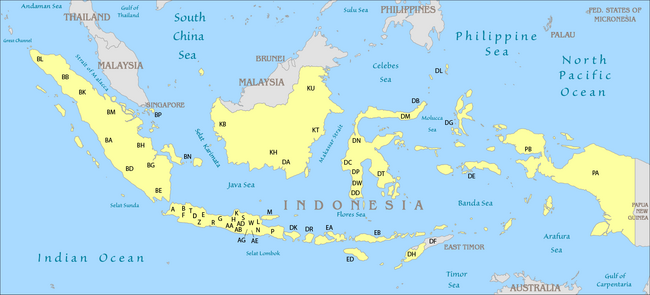 Several areas provide license plates for non-motorized transport vehicles. In Yogyakarta, YB is used for rickshaws. A white-on-blue license plate with area code SB is issued for rickshaws operating in the city of Surabaya. In Banjarmasin, rickshaws operating in the city are issued with plate using a unique format, XXXX BS.[citation needed] Defunct area codesThere were some area codes that are no longer in use anymore. These include:
HistoryColonial era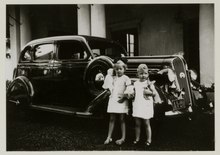 Vehicle registration plates were first introduced in the Dutch East Indies in 1900. The early format included regional codes such as CH for Cirebon, SB for Surabaya, and SOK for the eastern coast of Sumatra; and registration numbers with no official standards. Plates were not always installed at the front and the rear of the vehicle; some owners affixed the plates on the side of the vehicle. For international purposes, the Government of the Dutch East Indies introduced the code IN for government vehicles. IN plates were elliptical and the registration numbers were placed below on a rectangular plate.[9] A more-structured system was introduced in 1917 with the implementation of regulations regarding the content of applications for number and driving licenses, the specification of numbers and letters, the models of number and driving licenses, the establishment of registers of holders of the licenses and the publication of the contents of the registers. The regulation obliged vehicle owners to register their vehicles. The Karesidenan-based system was first implemented on Java and afterwards elsewhere in the colony.[10] The alphabetical codes were:
Until the 1920s, regional codes were added along with the Karesidenan regional expansion. For example, Bogor used the code F, Bojonegoro used the code S, and Western Papua used the code DS.[9][11] Post-colonial era1980s The early format of registration plates remained in use after Indonesia proclaimed its independence in 1945. At the beginning of the 1980s, plates with four-digit numbers separated by a dot at the bottom that denote the month and year of expiry (e.g. 06•87) was introduced. Vehicle owners must pay a tax to renew the plate every five years. The typefaces are embossed. There were two variations of design during the New Order; the expiry date would be placed above or below the registration numbers.[11][12] 21st century Along with the increase of motorized vehicles in Indonesia, the technical design and specification of vehicle registration plates began to be regulated by the Direktorat Lalu Lintas Kepolisian Negara Republik Indonesia/Ditlantas Polri (Traffic Directorate) of the Indonesian National Police. The size of the license plates during the 2000s was 395 mm × 135 mm (15.6 in × 5.3 in) (four wheel vehicles or more) or 250 mm × 105 mm (9.8 in × 4.1 in) (two or three wheel vehicles) with wide alphabets and a stripe that separates the registration numbers and expiry date.[15] In the lower left and upper right corners is the Traffic Police symbol, and at the lower-right and upper-left corners is a "DIRLANTAS POLRI" sign as a security feature and proof of the originality of the license plate.  In April 2011, the design of the license plate was redesigned. The new plates are 5 cm (2.0 in) longer to accommodate more characters and the typeface is slimmer. The Traffic Corps of the Indonesian National Police (Korps Lalu Lintas Kepolisian Negara Republik Indonesia/Korlantas Polri) introduced their more-complete coat of arms, with shield and ribbon with the letter "Dharmakerta Marga Raksyaka". The phrase "DITLANTAS" became "KORLANTAS". The license plates are made from 1 mm (0.039 in)-thick aluminium with edge lines with the same color as the numbers. The size of the plate for two-or-three-wheeled vehicles now is 275 mm × 115 mm (10.8 in × 4.5 in), while for four-or-more-wheeled vehicles they are 430 mm × 135 mm (16.9 in × 5.3 in).[14][17]  Since June 2022, The Traffic Corps of the Indonesian National Police changed the color scheme for personal and rental vehicles from black plates with white letters to white plates with black letters. The new color scheme was implemented to ease the detection of motoring offenses with traffic enforcement cameras.[16] To increase the effectivity of the new color scheme, FE-Schrift typeface was first implemented for regular personal four-wheel plates only since November 2022. Besides that, commercial/public transport (black on yellow) and government-owned (white on red) vehicle plates began to use FE-Schrift at the same time. Registration plate design convention
Size and formatingIndonesian vehicle registration plates for four-wheel vehicles are approximately 460 mm × 135 mm (18.1 in × 5.3 in) and plates for two-or-three-wheel vehicles are approximately 275 mm × 115 mm. All plates are constructed from stamped sheet metal. With some exceptions, plates use the following format: LL NNNN LL where "L" are letters of the Latin alphabet, and "N" numbers from "0" to "9" (the first number is never a "0"). The first single-or-double-letter prefixes denote the area of registration. This is followed by number between 1 and 9999 without leading zeroes. This is then followed by one or two letters although they may be optional. For example: B 1897 RKT is a vehicle registered in East Jakarta city; it begins with B. A smaller, four-digit number separated by dot is located at the top (old format, with horizontal line as divider) or bottom (newer format, commonly without divider) of the plate with following format: NN•NN denoting the month and year of the plate's expiry (e.g. 01•28 means until January 2028). The owner must pay a tax to renew it every five years.[citation needed] Color schemeVehicles in Indonesia are coded based on their classes and uses. These are:[18]
Electric vehiclesThe Indonesian National Police has set a special license plate for electric vehicles with additional blue trim at the expiry date row in accordance with the regulations in the Decree of the Head of the Traffic Corps of the Indonesian National Police in 2020.[19][20][21] However, when personal fossil-fueled vehicle plates have changed the color scheme, personal EV plates are still using the old one (white on black) with blue trim, added with the implementation of FE-Schrift since November 2022.
Temporary registration platesSouth Sulawesi dealership plate for new vehicles. This temporary registration plate format is issued nationwide for all types of vehicles. This newer format is exclusively issued for cars in Greater Jakarta (except Bogor) Temporary registration plates currently have two formats, namely:
Former color scheme
Special code examplesVehicle category (Jakarta only)In Jakarta, these codes are applied based on vehicle categories. These include:[citation needed]
For example, B 9031 BAY indicates that the vehicle is a pickup, while B 1032 DFA indicates that the vehicle is a minibus. State officials A separate format exists for private vehicles belonging to government, military or police officials. Because most of these agencies are based in Jakarta, vehicles belonging to state officials use the B suffix, along with the four numbers that are assigned to the vehicle. The sub-area suffix is replaced with RF suffix code, indicating the vehicle belongs to a state official, followed by another letter that indicates the corresponding agency or institution of the state official.[23]
For example, B 1703 RFS indicates that the vehicle belongs to a civilian official, whilst B 1148 RFP indicates that the vehicle belongs to a police official. On 27 January 2023, the Traffic Corps of the Indonesian National Police announced that special RF plates would be discontinued in October 2023, due to often being misused by numbers of people.[24] By July 2023, the special RF plates has been replaced by ZZ plates. Special plate designsMilitary and police vehiclesThe Indonesian National Armed Forces Headquarter Detachment Plate. The Indonesian Air Force Plate. The "-10" suffix code indicates the Air Force's Quick Reaction Forces Command Daihatsu Xenia with the Indonesian Navy plate A motorcycle with the Indonesian Army plate. The "-02" suffix code indicates the Army's Special Forces Command A Toyota Vios with the Indonesian Ministry of Defense plate. The "-05" suffix indicates the Ministry of Defense's Directorate General of Materials, Facilities and Services. Military and police vehicles have their own colors and alpha-numeric conventions, including their insignia and/or the rank of the officer owning the vehicle, especially for high-ranking officers. Army-personnel vehicles are yellow on green background, plus a yellow star on the top. Navy-personnel plate is yellow on light blue, plus a yellow anchor. Air Force-personnel plate is yellow on dark blue, plus a red and white air force roundel. Police plate is yellow on black. Personnel in Armed Forces Headquarters uses yellow numbers on red background plates. Slightly similar, Ministry of Defense vehicles also uses yellow on red plates, only replacing Armed Forces' insignia with the Ministry's insignia. This is also being implemented on other military vehicles, such as motorcycles, jeeps, trucks, and tanks.[25] Military and Ministry of Defense vehicles use the numerical convention NNNNN-SS where "N" is for numbers from "0" to "9" for registration and "S" denotes a special suffix number/letter which denotes the type of office or unit in which the person who owns the vehicle belongs to.[26] The suffix codes are:[27]
Government officialsExecutive branch Vehicle registration plates belonging to senior government officials like the president or vice president always begins with RI which stands for Republik Indonesia and are followed by a number. For example, the president's registration plate is RI-1, and the vice president's is RI-2. Other senior officials such as government ministers, the chairman of the House of Representatives, the commander of the National Armed Forces and the chief of the National Police also share the same convention and are assigned the numbers after the President and vice president. These plates are used for everyday activities and have a black on white design. There are some very special numbers, which are INDONESIA 1 and INDONESIA 2 for the president and vice president, respectively. These numbers are used for ceremonial purposes, such as presidential/vice-presidential inaugurations, national day ceremonies and armed forces day. On inauguration day, at the time the new president and vice president take the oath, the plates are moved from the former presidential/vice-presidential cars to the new car. These numbers are also used for all ceremonial presidential/vice-presidential cars, and have a white-on-red design. Legislative branchIn May 2021, the Indonesian House of Representatives (Indonesian: Dewan Perwakilan Rakyat) introduced their owned special registration plates, in order to supervise their member's driving behavior. The plate design is similar to the Ministry of Defence's plate, but painted in black and white combination with the seal of the House of Representatives. The codes are:[28]
For members of the parliament, the format is xx-yy where xx is the member number and yy is the faction number. Foreign countries and international organizations Registration plates for vehicles belonging to the government of foreign countries or international organizations follow a different convention. They used to have black letters on a white background with black trim on the bottom. In June 2022, the black trim was scrapped, so the plates would look similar to regular personal vehicle plates. The plates have the letter CD (abbreviation of Corps Diplomatique, French for Diplomatic Corps) followed by two or three digits denoting the country or organization, followed by up to three digits of the serial number. For example, a car with number CD 66 88 is owned by Vietnam. Generally, the number 01 is reserved for an ambassador's official vehicle. The order of numbers is based on when they recognized Indonesia as a country. The United States was originally assigned CD 13; due to the stigma associated with the number 13, they asked the Indian delegation to exchange numbers. The list of countries and organizations follows: Consulates also use the same format but instead of using the letters CD, they use CC. Some foreign countries and international-organization vehicles in Jakarta use the B xxxxx yyy format and a normal white on black plate. Where xxxxx stands for five random digits, and yyy stands for the country or organization code. Vanity plates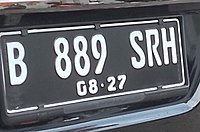 A few vehicle owners pay an extra amount of money to get a certain plate as their desire. Because the convention is not flexible to include a full word, people try creative uses of numbers and letters. For example, Idris Sardi, a violin player, uses (B 10 LA) for his vehicle. It is a play on the word BIOLA which means "violin" in Indonesian. Leoni, a famous actress and singer, uses L 30 NI for her car. Even the former President Megawati Soekarnoputri chooses "M 3 GA" for her personal vehicle, as the plate resembles her broadly-known nickname. Edhie Bhaskoro Yudhoyono, former President Yudhoyono's younger son, has "B 24 EB", which "EB" is being his name initial. With the new format of three suffix alphabets, many vanity or personal registration plates are possible to be created. For example, a Toyota Fortuner owner may choose the plate B 42 NER which sounds like B four-two-NER. Syahrini, an Indonesian singer, has "B 1 SYR" as her registration plate number, with "SYR" being her initials. See alsoReferences
External linksWikimedia Commons has media related to License plates of Indonesia.
|
|||||||||||||||||||||||||||||||||||||||||||||||||||||||||||||||||||||||||||||||||||||||||||||||||||||||||||||||||||||||||||||||||||||||||||||||||||||||||||||||||||||||||||||||||||||||||||||||||||||||||||||||||||||||||||||||||||||||||||||||||||||||||||||||||||||||||||||||||||||||||||||||||||||||||||||||||||||||||||||||||||||||||||||||||||||||||||||||||||||||||||||||||||||||||||||||||||||||||||||||||||||||||||||||||||||||||||||||||||||||||||||||||||||||||||||||||||||||||||||||||||||||||||||||||||||||||||||||||||||||||||||||||||||||||||||||||||||||||||||||||||||||||||||||||||||||||||||||||||||||||||||||||||||||||||||||||||













